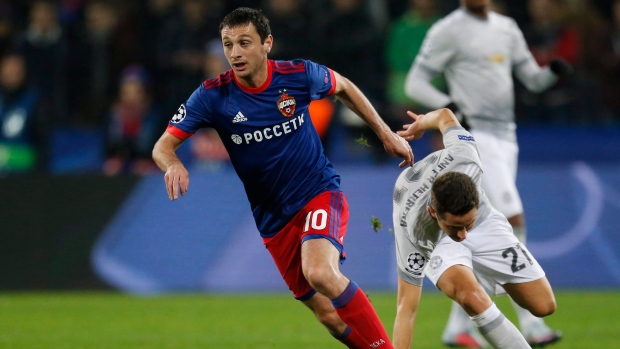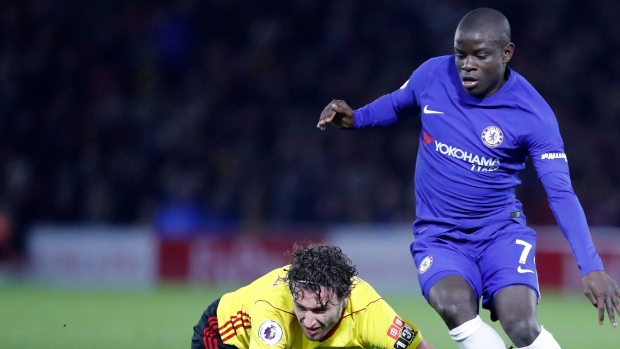May 23, 2018
Five midfielders to watch at the World Cup
TSN.ca continues its look ahead to next month's FIFA World Cup in Russia, turning the spotlight today on a quintet of midfielders to keep an eye on when the tournament kicks off on June 14. Each of these men is at a different stage in his career and carries with him a different burden in his pursuit for international glory in Russia.
TSN.ca Staff
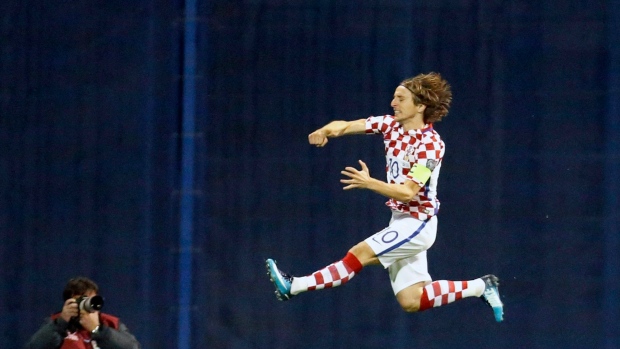
TSN.ca continues its look ahead to next month's FIFA World Cup in Russia, turning the spotlight today on a quintet of midfielders to keep an eye on when the tournament kicks off on June 14.
Each of these men is at a different stage in his career and carries with him a different burden in his pursuit for international glory in Russia.
Luka Modric, Croatia (Real Madrid)

In all likelihood, this is Luka Modric’s last World Cup. While he doesn’t appear to be slowing down at 32 and remains a linchpin at the heart of the Real Madrid midfield, Modric’s relationship with the national team is a complicated one.
Most of that is largely due to his relationship with a man named Zdravko Mamic, a kind of Svengali of Croatian football. A former executive at Dinamo Zagreb, Mamic and his brother were charged were tax fraud and bribery in 2015 over transfer irregularities at the club. Think of what happened as along the lines of Kia Joorabchian’s role in the transfers of Javier Mascherano and Carlos Tevez to West Ham in 2006, but somehow even shadier. Modric’s move to Tottenham Hotspur in 2008 was one of the transfers in question. At trial, Modric allegedly made false statements about the nature of his transfer and was subsequently charged with perjury. He is to stand trial at some point later this year.
Because of his association with Mamic, Modric isn’t necessarily the most popular figure amongst Croatian fans. If you recall at Euro 2016, Croatian fans flung flares onto the pitch in a game against the Czech Republic in protest of Mamic, who was also the vice-chairman of the Croatian FA, and anybody aligned with him.
It’s with this backdrop, then, that Modric heads to Russia. Modric finds himself in a midfield not as dominant as the all-world group he plays in at the Bernabeu, but it’s a skilled one that can cause problems in a potentially perilous group that also includes Nigeria, Iceland and Argentina.
In a setup with five in the midfield, Modric will likely slot in behind the strikers with Barcelona’s Ivan Rakitic and Inter’s Ivan Perisic on the wings and Real teammate Mateo Kovacic and Marcelo Brozovic of Inter behind him and ahead of the backline. The potential for fluid ball movement amongst this group is great and if they can get the lone striker – presumably Juve’s Mario Mandzukic – involved, there shouldn’t be any issue with offence for Zlatko Dalic’s team.
Another third-place finish like Croatia achieved in 1998 might be a longshot for this squad, but there’s no reason to think Modric and company can’t reach the knockout round.
Hector Herrera, Mexico (Porto)
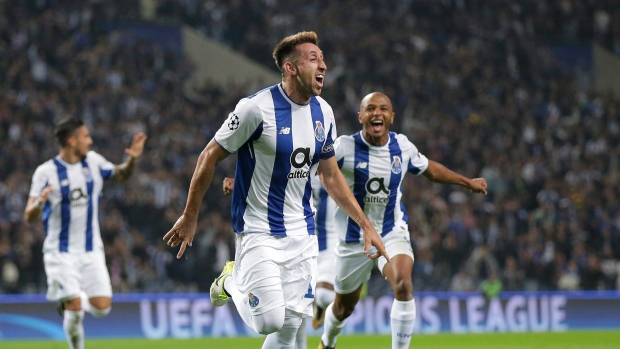
With a midfield that will be mostly North American-based, Juan Carlos Osorio hopes that Porto’s Hector Herrera can a bit of European flair to El Tri.
A product of the Pachuca youth system, Herrera first grabbed the attention of European scouts during the 2012 London Summer Olympics when he and the Mexico squad won gold in the tournament, defeating a Brazil team that featured Neymar, Marcelo, Danilo and Thiago Silva among others. Herrera scored in a quarterfinals win over Senegal.
With the likes of Liverpool and Newcastle reportedly interested in Herrera’s services, he signed with Porto in 2013 where the native of Tijuana has developed into a key cog in Sergio Conceicao’s midfield. Herrera, 28, tasted Liga NOS triumph for the first time this season when Porto held off Benfica to claim its first title since 2013. Herrera had a solid season on both sides of the ball. In 28 appearances in the league, Herrera notched three goals and added four assists. He averaged 2.8 tackles and 1.8 interceptions a match, continuing his play as one of Portugal’s finest box-to-box midfielders.
Like for many players heading into the tournament, Russia could have major ramifications for where Herrera plays next season. Throughout Porto’s domestic and European campaigns, a host of scouts from top clubs across the continent made it a point to track Herrera this past season and could very well be prepping a transfer offer to the Dragons. Among those believed to have been monitoring Herrera include Milan, Arsenal, Manchester United and Watford.
As for El Tri, look for Osorio to play a 4-3-3 and Herrera to slot in just ahead of the backline. Capped 63 teams, Herrera and Real Betis’s Andres Guardado will be called upon to dictate the pace in the middle of the park with, perhaps, Tigres’ Javier Aquino as the third man. If the El Tri midfield can provide service to an exciting attack featuring the in-form Hirving Lozano of PSV and West Ham’s Javier “Chicharito” Hernandez, Mexico will like its chances to move on from an interesting Group F that also includes holders Germany, South Korea and Sweden.
Alan Dzagoev, Russia (CSKA Moscow)
In many ways, Alan Dzagoev is the star who wasn’t.
A member of the Russian side that took Euro 2008 by storm and made a surprise run to the semi-finals (where they were ultimately defeated by eventual champions, Spain), Dzagoev was emblematic of an ascendant Russia that appeared to be an impending powerhouse in European football, but it never happened for him and it didn’t happen for Russia.
Russia failed to qualify for the 2010 World Cup. At Euro 2012, the Russians couldn’t get out of the group stage. A winless Russia also exited both the World Cup in 2014 and Euro 2016 in the group stages. So what happened to Russia and what happened to Dzagoev?
While some of his contemporaries like Andrei Arshavin and Yuri Zhirkov headed abroad to ply their trades in some of Europe’s top leagues, Dzagoev stayed at CSKA, the club he’s now been at for a decade. CSKA remains a Russian powerhouse and has claimed Russian Premier League titles three times in the past 10 years.
While Dzagoev has played his part in those championship victories and Champions League qualification (he scored three times and added seven assists in league play this year), it just seems like he could have been capable of more. But why leave your home if you don’t have to? Because of rules put in place by the Russian FA to limit the amount of foreign players coming into the Premier League as a means to cultivate homegrown talent, teams pay high prices for Russian players and an international talent like Dzagoev remains one of the league’s top earners. So while he’s not playing in Serie A or the Bundesliga, Dzagoev is being paid like he is.
And none of this is to say that Dzagoev, 27, still isn’t capable of helping Russia star in front of its home fans next month. In a group with Uruguay, Egypt and Saudi Arabia, Stanislav Cherchesov’s team certainly sees a path to the knockout round. With Spartak’s Denis Glushakov not selected, Dzagoev will be called upon to be the straw that stirs the drink in the midfield and provider for the Russian attack. Dzagoev will likely play furthest forward and in behind the strikers in a five-man midfield. If he can get service to the likes of Zenit’s Aleksandr Korokin, Artem Dzyuba of Arsenal Tula or Lokomotiv’s Aleksei Miranchuk, Russia could be cooking.
Though this World Cup can’t erase the seemingly missed opportunities from past tournaments, for Russia and Dzagoev, it represents one last shot at changing an unflattering narrative.
Shinji Kagawa, Japan (Borussia Dortmund)
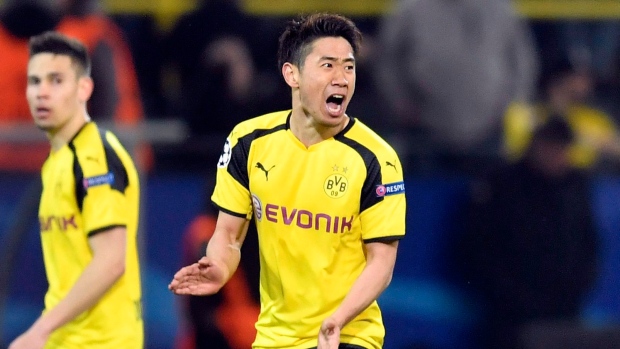
The World Cup comes around at an odd juncture in Shinji Kagawa’s career.
After a season in which he scored 13 goals for a marauding BVB attack that romped to a second straight Bundesliga title, Kagawa made the jump to the Premier League and Manchester United in 2012. His English adventure was an ill-fated one. Kagawa made just 38 appearances over two seasons with neither Sir Alex Ferguson nor David Moyes getting the best out of his skillset or Kagawa firmly ensconcing himself as an indispensable part of the first team.
A return to the comforts of Dortmund seemed like a good solution for both Kagawa and the club, but four managers in four seasons has been a mixed bag for the player. Kagawa, perhaps, hit his lowest ebb with the club this season under Peter Bosz. With the likes of Christian Pulisic, Julian Weigl and Gonzalo Castro preferred to him in the midfield, Kagawa found himself on the periphery of the first team.
But his fortunes changed dramatically after the appointment of Peter Stoger, who assumed managerial duties in December to replace Bosz. With Stoger moving Kagawa back to the centre of the midfield, the now 29-year-old looked more like the player that helped Jürgen Klopp’s side win two titles at the beginning of the decade. Still pacey, but asked to play a bit deeper, it was clear that if Kagawa’s confidence had been dimmed, it had now returned.
So now heading into Russia, Kagawa is once again being tipped for a move back to the Premier League with Everton and West Ham apparently sniffing around his services. Will he be tempted to again take his chances in the world’s biggest league or stay in more familiar pastures where Kagawa seems settled again? Could the departure of Stoger and the arrival of new manager, Lucien Favre, also play into the decision?
Before any of that comes the little matter of the World Cup, the Samurai Blue’s sixth straight appearance. Not boding well for their chances is the Japanese FA’s choice to fire head coach Vahid Halilhodzic in April and replace him with Akira Nishino. But Kagawa and Japan are drawn into an interesting Group H with Senegal, Poland and Colombia, where there is the chance for Japan to sneak into the knockout round. There is no gamebreaker on this squad the stature of a Sadio Mane, Robert Lewandowski or James Rodriguez, but the triumvirate of Kagawa, Pachuca’s Keisuke Honda and Shinji Okazaki of Leicester City are capable of mustering up enough to cause some trouble.
The next few months of Shinji Kagawa’s career will be fascinating to watch.
N'Golo Kante, France (Chelsea)
If you saw N’Golo Kante on the street, there’s no way in hell you would think he was a footballer, let alone of the best and most influential midfielders in the game. He’s 5-foot-6 with a slight frame and could pass for much younger than his 27 years. But this man has dominated the English Premier League like few midfielders before him and is now among the embarrassment of riches inside a French midfield that also includes the likes of Manchester United’s Paul Pogba, Thomas Lemar of Monaco and Juve’s Blaise Matuidi.
Coming to England from Caen in 2015 with Leicester, Kante quickly emerged as a little buzz saw in the midfield, sitting on top of the central defensive pair of Wes Morgan and Robert Huth and linking up with Danny Drinkwater to help the Foxes capture the most unlikely of Premier League crowns in one of the most stunning upsets in sports history. He then went on to repeat the feat the following season with Chelsea, this time picking up a PFA Player of the Year award for his troubles, as well.
It’s not that Kante does things that people haven’t seen before; it’s just that he does them in the body of a much more slender man you’d expect. He’s like a Roy Keane or Gilberto Silva, but about the size of an Aaron Lennon and with more offensive flair and pace. And he doesn’t possess the mean streak of similar players. Whereas there was always a worry that, say, Patrick Vieira would pick up an untimely booking (or worse), Kante’s discipline is a hallmark of his game and one that has allowed him to emerge as an elite box-to-box midfielder.
Kante led the Premier League in interceptions this season with 85 and averaged 3.2 tackles a game in the league. Part and parcel to his discipline is his seemingly preternatural gift of timing that Kante uses to great advantage and picked up a scant three bookings in nearly 3,000 minutes of play this season.
France manager Didier Deschamps, a fine defensive midfielder in his day, likely sees a kindred spirit in Kante and will task him with anchoring his impressive midfield. If France plays to its abilities, there are few teams in Russia who can compete with that level of sheer talent and Les Bleus rightfully stand as one of the favourites to win it all next month.

